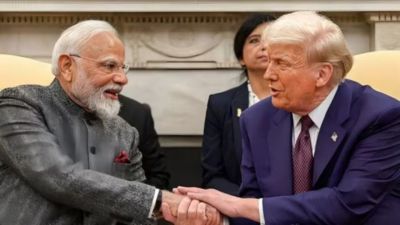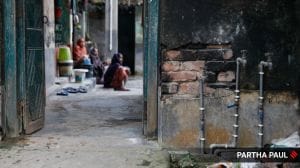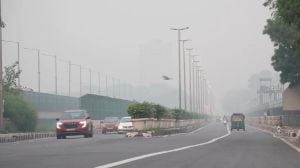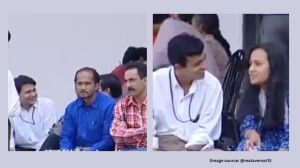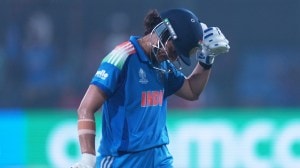Beg your pardon, Mr President?
PRESIDENT A.P.J. Abdul Kalam has, it appears, long been in a mood for mercy. When the case file of Dhananjoy Chatterjee — convicted for...

 PRESIDENT A.P.J. Abdul Kalam has, it appears, long been in a mood for mercy. When the case file of Dhananjoy Chatterjee — convicted for raping and murdering a teenaged girl in Kolkata — was put before him in 2004, he realised Chatterjee’s mercy plea had already been rejected by two former presidents, Shankar Dayal Sharma and K.R. Narayanan. Chatterjee was finally executed on August 14, 2004, after having spent 14 years in prison.
PRESIDENT A.P.J. Abdul Kalam has, it appears, long been in a mood for mercy. When the case file of Dhananjoy Chatterjee — convicted for raping and murdering a teenaged girl in Kolkata — was put before him in 2004, he realised Chatterjee’s mercy plea had already been rejected by two former presidents, Shankar Dayal Sharma and K.R. Narayanan. Chatterjee was finally executed on August 14, 2004, after having spent 14 years in prison.
Chatterjee hanged to death but the president still had a huge pile of mercy petitions to sign off. His predecessor, Narayanan, had left him with an unhappy inheritance of 12 pending files, the number having now grown to 20. Shortly after the UPA government took office, Kalam referred all the files back to the Home Ministry.
In doing so, he was following the norm of presidents referring pending matters and appointments for a possible change when a new regime was sworn in. But perhaps he also hoped there would be a change in recommendation from the new home minister, Shivraj Patil.
What is a mercy petition? Simply, it is a letter written to the president by a person whose death sentence has been confirmed by the Supreme Court, appealing to the head of state for pardon or commutation.
|
In 2004, following the president’s nudge, the Home Ministry did a painstaking review of the 20 mercy petitions. It sent them back one by one, rejecting every single appeal |
Theoretically, the president can exercise his judgement. In practice, he is sent a recommendation on the individual case by the government, through the home minister.
FOLLOWING Kalam’s nudge, the Home Ministry’s Judicial Department did a painstaking review of all the cases. It returned the files, one by one, to Rashtrapati Bhavan. On each file, the recommendation remained unchanged — the mercy petition was worthy of rejection.
But the president persisted. He is known to have informally discussed the subject of the sorry plight of the 50-odd death row petitioners with Patil, more than once.
Patil, in turn, urged Home Ministry officials to take up the subject of the presidential pardon with senior jurists. The feedback was an iteration of cold, death row statistics and constitutional law. That the death penalty had been delivered in these 20 cases guided by the Supreme Court’s ‘‘rarest of rare’’ principle and that there were no legal lacunae in the judgements or appeals appended for the president’s perusal.
|
The quality of presidential mercy
|
||
‘‘The chain of evidence remains incomplete and inference of guilt on circumstantial evidence is not wholly justified. I would ask the home minister to reconsider the question of death sentence from this point of view.’’
THIS formed part of the detailed note India’s first president, Rajendra Prasad, sent in 1959 to the then home minister asking for the commutation of one Boya Gundlayya’s death sentence. The note contained a listing of the legal lacunae in the prosecution’s case. THE current controversy is, perhaps, partly a result of increased pressure on India to join the club of abolitionist nations. Some countries are wary of extradition treaties with India, given that the death penalty is legal here. |
The president’s next move took the Home Ministry by surprise. Within weeks of the last file being returned to Rashtrapati Bhavan, he sent a personal note to Patil asking that his ministry review its recommendations and consider clemency for the petitioners.
Officials familiar with the correspondence say the files came back in three bulky bundles. The president had carefully catalogued the cases and given suggestions on possible remedial and rehabilitation methods the Home Ministry could adopt. Kalam is understood to have named specific convicts who had crossed 75, or belonged to the poorest strata of society, or for whom there was no scope of recidivism.
KALAM’S move — of asking for an omnibus review of pending mercy plea cases — has, predictably, rekindled the debate on the death penalty. But more important, it has put focus back on the grey area of the scope and limitations of the presidential pardon.
While Article 72 of the Constitution gives the president ‘‘power to grant pardons, reprieves, respites or remissions’’, whether the president is meant to exercise these powers, as laid down in the Constitution, only with the aid and advice of the council of ministers continues to be a subject of interpretation.
When asked, Justice Y.K. Sabharwal, the Supreme Court’s chief justice designate, said he was ‘‘personally’’ in favour of India abolishing the death penalty, but it was for the executive to draw up guidelines for a presidential pardon. ‘‘It is upto the government and Parliament to sort this out,’’ Justice Sabharwal said, ‘‘we will deliberate on the issue when it comes before us.’’
Senior jurists contacted by The Sunday Express appeared sharply divided. Former Chief Justice P.N. Bhagwati, who has spoken against the death penalty and gave a note of dissent in the landmark State of Punjab verses Bachchan Singh judgement of 1980, described the power of the president as ‘‘unfettered’’.
As Justice Bhagwati put it, ‘‘The president has absolute powers of deciding on a mercy plea and he is not bound to listen to the advice of the Home Ministry. But he should take reasonable time in doing so, and I find it absurd that when a man’s life hangs in balance on death row, a petition sould be pending for seven or eight years.’’
However, retired Justice V.R. Krishna Iyer was adamant that the scope of the presidential pardon was limited. ‘‘The president can express his personal view on a case but he has no powers to overrule the recommendation of the council of ministers. After a review, the president is obliged to accept the decision of the cabinet.’’
|
Dead men walking
|
||
| Those who’ve appealed to Kalam’s court’ Story continues below this ad
Rajiv Gandhi assassination: The clemency appals of three conspirators, Murugan, G. Perarivalan and Chinna Shanthan, are pending since 2000. The case is 14 years old and the death sentence of Murugan’s wife, S. Nalini, was commuted to life imprisonment. |
OVER the years, the Supreme Court has stopped short of pronouncing on the time limit for a president to deliberate or decide on a mercy petition. Despite this legal position, earlier this year one convict whose plea is lying before President Kalam filed a petition in the Chennai High Court. He demanded the inordinate delay in deciding his clemency case be taken as ground for commutation.
In 1983, in T.V. Vaitheeswaran vs State of Tamil Nadu, a two-judge bench ruled that a delay exceeding two years in the execution of a death sentence could be considered sufficient to entitle a person to invoke Article 21 and demand quashing of the sentence.
But in 1989, in the Trivenben case, a constitutional bench of the Supreme Court held that grounds of delay entitling a convict to demand commutation of a death sentence could only be based on any ‘‘inhuman suffering’’ and mental torture the convict had undergone while waiting for the hangman.
This is the line of argument President Kalam appears to have picked. North Block officials say the president seems to have consulted legal experts before asking for an across-the-board review.
There is no word from Rashtrapati Bhavan on which legal minds the president has tapped. Janak Raj Jai — a Supreme Court lawyer who recently published a book on the death penalty — says President Kalam called him for a chat in mid-August.
The president had tagged pages of the book and said he had examined each pending clemency case,’’ Jai remembers, ‘‘the president was very keen to hear suggestions on what treatment and care aged death wow detenues should get in case they were given mercy by the government.’’
Several Indian and Western jurists have pointed to the discrimination factor in the delivery of death penalties in India.
Within days of sending the files back to the Home Ministry, Kalam again spoke his mind at a function at Hyderabad’s National Police Academy.
He admitted to having examined each clemency file and wondered why, in India, only the poorest of the poor were convicted for heinous crimes.
The Home Ministry has not reacted to the president’s unprecedented action, not yet at any rate. The only word from Home Minister Shivraj Patil is that he will make a detailed statement on the issue in Parliament.
Meanwhile, the Judicial Department in his ministry is furiously ‘‘working’’ on the clemency cases. President Kalam has set the cat among pigeons.





- 01
- 02
- 03
- 04
- 05


